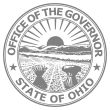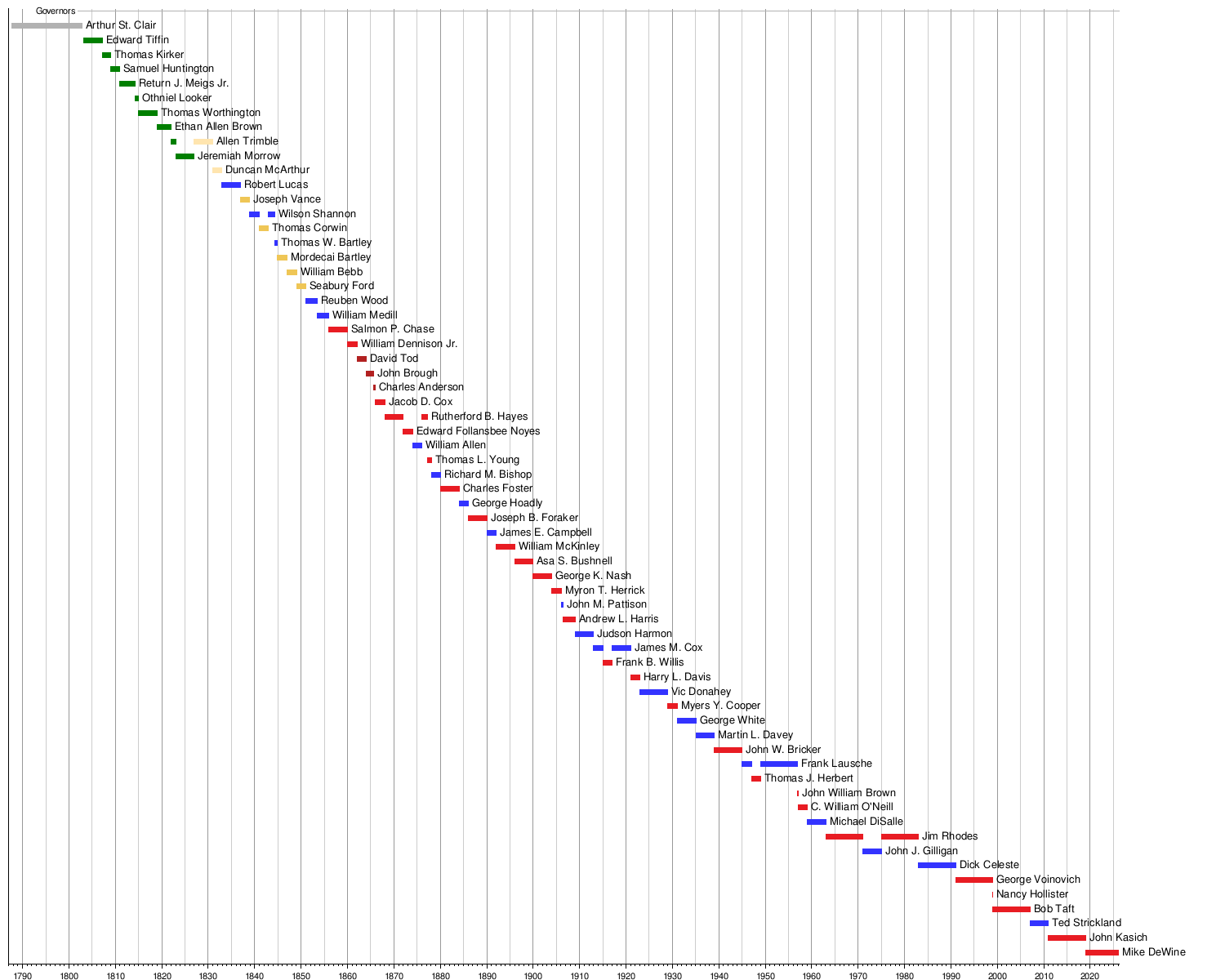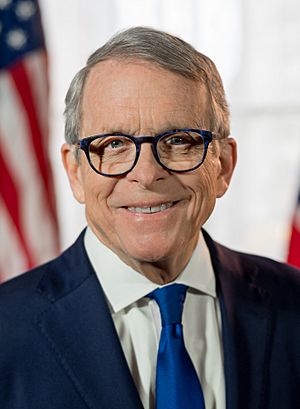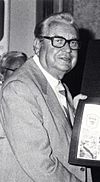List of governors of Ohio facts for kids
Quick facts for kids Governor of the State of Ohio |
|
|---|---|

Standard of the governor of Ohio
|
|

Seal of the governor of Ohio
|
|
| Government of Ohio | |
| Style | The Honorable |
| Residence | Ohio Governor's Mansion |
| Term length | Four years, renewable once consecutively |
| Inaugural holder | Edward Tiffin |
| Formation | March 3, 1803 |
| Succession | Line of succession |
| Deputy | Lieutenant Governor of Ohio |
| Salary | $168,106 (2022) |
The governor of Ohio is like the main boss of the state of Ohio. They are the head of government, meaning they lead the state's executive branch. They are also the commander-in-chief of Ohio's military forces, like the Ohio National Guard.
The governor's job is to make sure state laws are followed. They can also approve or reject (this is called a veto) new laws passed by the Ohio General Assembly. They have the power to call the legislature together for special meetings. The governor can also grant pardons, which means forgiving someone for a crime, except in very serious cases like treason or impeachment.
Ohio has had 64 different governors. Some governors have served more than one term. The longest-serving governor was Jim Rhodes, who was elected four times. He served almost sixteen years in total. The shortest terms were held by John William Brown and Nancy Hollister. They each served for only 11 days. This happened when the previous governors resigned to take new jobs.
The current governor is Mike DeWine. He is a Republican and started his term on January 14, 2019. He was re-elected in 2022. A governor can only serve two terms in a row.
Contents
Becoming Governor: What It Takes

To become the governor of Ohio, you need to meet certain requirements. You must be a qualified voter in the state. This means you need to be at least 18 years old when the election happens. You also need to have lived in Ohio for at least 30 days before the election. And, of course, you must be a U.S. citizen.
People who have been convicted of serious crimes or are found unable to vote by a court cannot be governor. There's a rule that a governor can only serve two terms in a row.
Governor's Powers and Duties
The governor has many important jobs and powers. They are the leader of the state's military forces. They must make sure all state laws are carried out.
Here are some other things the governor does:
- They make sure all laws are followed. They can ask for written reports from any state office.
- They give a yearly speech to the General Assembly. In this speech, they suggest new laws.
- They can call special meetings of the legislature for specific reasons.
- If the two parts of the legislature can't agree on when to end their session, the governor can decide.
- They keep and use "The Great Seal of the State of Ohio." This is an official stamp for state documents.
- They sign and seal all official papers given out by the state of Ohio.
- If the Lieutenant Governor's job becomes empty, the governor can suggest a new person. Both parts of the legislature must agree.
- They can fill empty spots for other important state jobs. These include the Auditor, Treasurer, Secretary of State, and Attorney General.
- They get reports from each state department at least once a year. They include these reports in their yearly speech to the legislature.
- They make all other appointments that aren't already decided. The Senate must agree to these appointments. If the Senate doesn't act, the governor's choice still takes the job.
Who Takes Over? (Succession)
If the governor's job becomes empty, the lieutenant governor becomes governor. This can happen if the governor dies, resigns, or is removed from office. If the lieutenant governor's job is also empty, the president of the senate becomes the acting governor.
If both jobs become empty early in the term (within the first 20 months), a special election is held. This election chooses new leaders to finish the term. Before 1851, the speaker of the senate would act as governor. Since 1978, the governor and lieutenant governor are elected together. Before that, they could be from different political parties.
Ohio's Governors Through History
Northwest Territory Governors
Before Ohio became a state, it was part of the Northwest Territory. This territory was set up in 1787. Over time, other states and territories were created from it. Ohio became a state on March 1, 1803.
The Northwest Territory had only one governor appointed by the U.S. government: Arthur St. Clair. He was removed from office in 1802. No one else was named governor before Ohio became a state. The Secretary of the Territory, Charles Willing Byrd, acted as governor until Ohio officially joined the Union.
| Governor | Term in office | Appointed by | |
|---|---|---|---|
 |
Arthur St. Clair (1737–1818) |
October 5, 1787 – November 22, 1802 (removed) |
Continental Congress |
| George Washington | |||
| John Adams | |||
Governors of the State of Ohio
Ohio became a state on March 1, 1803. Since then, it has had 64 governors. Some, like Allen Trimble and Jim Rhodes, served terms that were not in a row.
The first Ohio constitution (from 1803) said governors could serve two-year terms. They could serve up to six years out of any eight-year period. The current constitution (from 1851) removed this limit. It also changed the start of the term to January. In 1908, Ohio changed its election years from odd to even numbers. A change in 1957 made terms four years long. It also said governors could only serve two terms in a row. After two terms, they have to wait four years before running again.
| No. | Governor | Term in office | Party | Election | Lt. Governor | |||
|---|---|---|---|---|---|---|---|---|
| 1 |  |
Edward Tiffin (1766–1829) |
March 3, 1803 – March 4, 1807 (resigned) |
Democratic- Republican |
1803 | Office did not exist | ||
| 1805 | ||||||||
| 2 |  |
Thomas Kirker (1760–1837) |
March 4, 1807 – December 12, 1808 (lost election) |
Democratic- Republican |
Speaker of the Senate acting |
|||
| 1807 | ||||||||
| 3 |  |
Samuel Huntington (1765–1817) |
December 12, 1808 – December 8, 1810 (did not run) |
Democratic- Republican |
1808 | |||
| 4 |  |
Return J. Meigs Jr. (1764–1825) |
December 8, 1810 – March 25, 1814 (resigned) |
Democratic- Republican |
1810 | |||
| 1812 | ||||||||
| 5 |  |
Othniel Looker (1757–1845) |
March 25, 1814 – December 8, 1814 (lost election) |
Democratic- Republican |
Speaker of the Senate acting |
|||
| 6 |  |
Thomas Worthington (1773–1827) |
December 8, 1814 – December 14, 1818 (did not run) |
Democratic- Republican |
1814 | |||
| 1816 | ||||||||
| 7 |  |
Ethan Allen Brown (1776–1852) |
December 14, 1818 – January 4, 1822 (resigned) |
Democratic- Republican |
1818 | |||
| 1820 | ||||||||
| 8 |  |
Allen Trimble (1783–1870) |
January 4, 1822 – December 28, 1822 (lost election) |
Democratic- Republican |
Speaker of the Senate acting |
|||
| 9 |  |
Jeremiah Morrow (1771–1852) |
December 28, 1822 – December 19, 1826 (did not run) |
Democratic- Republican |
1822 | |||
| 1824 | ||||||||
| 10 |  |
Allen Trimble (1783–1870) |
December 19, 1826 – December 18, 1830 (did not run) |
National Republican |
1826 | |||
| 1828 | ||||||||
| 11 |  |
Duncan McArthur (1772–1839) |
December 18, 1830 – December 7, 1832 (did not run) |
National Republican |
1830 | |||
| 12 |  |
Robert Lucas (1781–1853) |
December 7, 1832 – December 13, 1836 (did not run) |
Democratic | 1832 | |||
| 1834 | ||||||||
| 13 |  |
Joseph Vance (1786–1852) |
December 13, 1836 – December 13, 1838 (lost election) |
Whig | 1836 | |||
| 14 |  |
Wilson Shannon (1802–1877) |
December 13, 1838 – December 16, 1840 (lost election) |
Democratic | 1838 | |||
| 15 |  |
Thomas Corwin (1794–1865) |
December 16, 1840 – December 14, 1842 (lost election) |
Whig | 1840 | |||
| 16 |  |
Wilson Shannon (1802–1877) |
December 14, 1842 – April 15, 1844 (resigned) |
Democratic | 1842 | |||
| 17 |  |
Thomas W. Bartley (1812–1885) |
April 15, 1844 – December 3, 1844 (lost nomination) |
Democratic | Speaker of the Senate acting |
|||
| 18 |  |
Mordecai Bartley (1783–1870) |
December 3, 1844 – December 12, 1846 (did not run) |
Whig | 1844 | |||
| 19 |  |
William Bebb (1802–1873) |
December 12, 1846 – January 22, 1849 (did not run) |
Whig | 1846 | |||
| 20 |  |
Seabury Ford (1801–1855) |
January 22, 1849 – December 12, 1850 (did not run) |
Whig | 1848 | |||
| 21 |  |
Reuben Wood (d. 1864) |
December 12, 1850 – July 13, 1853 (resigned) |
Democratic | 1850 | |||
| 1851 | William Medill | |||||||
| 22 |  |
William Medill (1802–1865) |
July 13, 1853 – January 14, 1856 (lost election) |
Democratic | Succeeded from lieutenant governor |
Vacant | ||
| 1853 | James Myers | |||||||
| 23 |  |
Salmon P. Chase (1808–1873) |
January 14, 1856 – January 9, 1860 (did not run) |
Republican | 1855 | Thomas H. Ford | ||
| 1857 | Martin Welker | |||||||
| 24 |  |
William Dennison Jr. (1815–1882) |
January 9, 1860 – January 13, 1862 (did not run) |
Republican | 1859 | Robert C. Kirk | ||
| 25 |  |
David Tod (1805–1868) |
January 13, 1862 – January 11, 1864 (lost nomination) |
Union | 1861 | Benjamin Stanton | ||
| 26 |  |
John Brough (1811–1865) |
January 11, 1864 – August 29, 1865 (died in office) |
Union | 1863 | Charles Anderson | ||
| 27 |  |
Charles Anderson (1814–1895) |
August 29, 1865 – January 8, 1866 (did not run) |
Union | Succeeded from lieutenant governor |
Vacant | ||
| 28 |  |
Jacob Dolson Cox (1828–1900) |
January 8, 1866 – January 13, 1868 (did not run) |
Republican | 1865 | Andrew McBurney | ||
| 29 |  |
Rutherford B. Hayes (1822–1893) |
January 13, 1868 – January 8, 1872 (did not run) |
Republican | 1867 | John C. Lee | ||
| 1869 | ||||||||
| 30 |  |
Edward Follansbee Noyes (1832–1890) |
January 8, 1872 – January 12, 1874 (lost election) |
Republican | 1871 | Jacob Mueller | ||
| 31 |  |
William Allen (1803–1879) |
January 12, 1874 – January 10, 1876 (lost election) |
Democratic | 1873 | Alphonso Hart | ||
| 32 |  |
Rutherford B. Hayes (1822–1893) |
January 10, 1876 – March 2, 1877 (resigned) |
Republican | 1875 | Thomas L. Young | ||
| 33 |  |
Thomas L. Young (1832–1888) |
March 2, 1877 – January 14, 1878 (did not run) |
Republican | Succeeded from lieutenant governor |
H. W. Curtiss (acting) |
||
| 34 |  |
Richard M. Bishop (1812–1893) |
January 14, 1878 – January 12, 1880 (lost nomination) |
Democratic | 1877 | Jabez W. Fitch | ||
| 35 |  |
Charles Foster (1828–1904) |
January 12, 1880 – January 14, 1884 (did not run) |
Republican | 1879 | Andrew Hickenlooper | ||
| 1881 | Rees G. Richards | |||||||
| 36 |  |
George Hoadly (1826–1902) |
January 14, 1884 – January 11, 1886 (lost election) |
Democratic | 1883 | John G. Warwick | ||
| 37 |  |
Joseph B. Foraker (1846–1917) |
January 11, 1886 – January 13, 1890 (lost election) |
Republican | 1885 | Robert P. Kennedy (resigned March 3, 1887) |
||
| Silas A. Conrad | ||||||||
| 1887 | William C. Lyon | |||||||
| 38 |  |
James E. Campbell (1843–1924) |
January 13, 1890 – January 11, 1892 (lost election) |
Democratic | 1889 | Elbert L. Lampson (replaced January 31, 1890) |
||
| William V. Marquis | ||||||||
| 39 |  |
William McKinley (1843–1901) |
January 11, 1892 – January 13, 1896 (did not run) |
Republican | 1891 | Andrew L. Harris | ||
| 1893 | ||||||||
| 40 |  |
Asa S. Bushnell (1834–1904) |
January 13, 1896 – January 8, 1900 (did not run) |
Republican | 1895 | Asa W. Jones | ||
| 1897 | ||||||||
| 41 |  |
George K. Nash (1842–1904) |
January 8, 1900 – January 11, 1904 (did not run) |
Republican | 1899 | John A. Caldwell | ||
| 1901 | Carl L. Nippert (resigned May 1, 1902) |
|||||||
| Harry L. Gordon | ||||||||
| 42 |  |
Myron T. Herrick (1854–1929) |
January 11, 1904 – January 8, 1906 (lost election) |
Republican | 1903 | Warren G. Harding | ||
| 43 |  |
John M. Pattison (1847–1906) |
January 8, 1906 – June 18, 1906 (died in office) |
Democratic | 1905 | Andrew L. Harris | ||
| 44 |  |
Andrew L. Harris (1835–1915) |
June 18, 1906 – January 11, 1909 (lost election) |
Republican | Succeeded from lieutenant governor |
Vacant | ||
| 45 |  |
Judson Harmon (1846–1927) |
January 11, 1909 – January 13, 1913 (did not run) |
Democratic | 1908 | Francis W. Treadway | ||
| 1910 | Atlee Pomerene (resigned March 4, 1911) |
|||||||
| Hugh L. Nichols | ||||||||
| 46 |  |
James M. Cox (1870–1957) |
January 13, 1913 – January 11, 1915 (lost election) |
Democratic | 1912 | W. A. Greenlund | ||
| 47 |  |
Frank B. Willis (1871–1928) |
January 11, 1915 – January 8, 1917 (lost election) |
Republican | 1914 | John H. Arnold | ||
| 48 |  |
James M. Cox (1870–1957) |
January 8, 1917 – January 10, 1921 (did not run) |
Democratic | 1916 | Earl D. Bloom | ||
| 1918 | Clarence J. Brown | |||||||
| 49 |  |
Harry L. Davis (1878–1950) |
January 10, 1921 – January 8, 1923 (did not run) |
Republican | 1920 | |||
| 50 |  |
A. Victor Donahey (1873–1946) |
January 8, 1923 – January 14, 1929 (did not run) |
Democratic | 1922 | Earl D. Bloom | ||
| 1924 | Charles H. Lewis | |||||||
| 1926 | Earl D. Bloom (resigned April 1928) |
|||||||
| William G. Pickrel (term ended November 1928) |
||||||||
| George C. Braden | ||||||||
| 51 |  |
Myers Y. Cooper (1873–1958) |
January 14, 1929 – January 12, 1931 (lost election) |
Republican | 1928 | John T. Brown | ||
| 52 |  |
George White (1872–1953) |
January 12, 1931 – January 14, 1935 (did not run) |
Democratic | 1930 | William G. Pickrel | ||
| 1932 | Charles W. Sawyer | |||||||
| 53 |  |
Martin L. Davey (1884–1946) |
January 14, 1935 – January 9, 1939 (lost nomination) |
Democratic | 1934 | Harold G. Mosier | ||
| 1936 | Paul P. Yoder | |||||||
| 54 |  |
John W. Bricker (1893–1986) |
January 9, 1939 – January 8, 1945 (did not run) |
Republican | 1938 | Paul M. Herbert | ||
| 1940 | ||||||||
| 1942 | ||||||||
| 55 |  |
Frank Lausche (1895–1990) |
January 8, 1945 – January 13, 1947 (lost election) |
Democratic | 1944 | George D. Nye | ||
| 56 |  |
Thomas J. Herbert (1894–1974) |
January 13, 1947 – January 10, 1949 (lost election) |
Republican | 1946 | Paul M. Herbert | ||
| 57 |  |
Frank Lausche (1895–1990) |
January 10, 1949 – January 3, 1957 (resigned) |
Democratic | 1948 | George D. Nye | ||
| 1950 | ||||||||
| 1952 | John William Brown | |||||||
| 1954 | ||||||||
| 58 |  |
John William Brown (1913–1993) |
January 3, 1957 – January 14, 1957 (successor took office) |
Republican | Succeeded from lieutenant governor |
Vacant | ||
| 59 |  |
C. William O'Neill (1916–1978) |
January 14, 1957 – January 12, 1959 (lost election) |
Republican | 1956 | Paul M. Herbert | ||
| 60 |  |
Michael DiSalle (1908–1981) |
January 12, 1959 – January 14, 1963 (lost election) |
Democratic | 1958 | John W. Donahey | ||
| 61 |
|
Jim Rhodes (1909–2001) |
January 14, 1963 – January 11, 1971 (term-limited) |
Republican | 1962 | John William Brown | ||
| 1966 | ||||||||
| 62 |  |
John J. Gilligan (1921–2013) |
January 11, 1971 – January 13, 1975 (lost election) |
Democratic | 1970 | |||
| 63 |
|
Jim Rhodes (1909–2001) |
January 13, 1975 – January 10, 1983 (term-limited) |
Republican | 1974 | Dick Celeste | ||
| 1978 | George Voinovich (resigned November 1979) |
|||||||
| Vacant | ||||||||
| 64 |  |
Dick Celeste (b. 1937) |
January 10, 1983 – January 14, 1991 (term-limited) |
Democratic | 1982 | Myrl Shoemaker (died July 30, 1985) |
||
| Vacant | ||||||||
| 1986 | Paul Leonard | |||||||
| 65 |  |
George Voinovich (1936–2016) |
January 14, 1991 – December 31, 1998 (resigned) |
Republican | 1990 | Mike DeWine (resigned November 12, 1994) |
||
| Vacant | ||||||||
| 1994 | Nancy Hollister | |||||||
| 66 |  |
Nancy Hollister (b. 1949) |
December 31, 1998 – January 11, 1999 (successor took office) |
Republican | Succeeded from lieutenant governor |
Vacant | ||
| 67 |  |
Bob Taft (b. 1942) |
January 11, 1999 – January 8, 2007 (term-limited) |
Republican | 1998 | Maureen O'Connor (resigned December 31, 2002) |
||
| Vacant | ||||||||
| 2002 | Jennette Bradley (resigned January 5, 2005) |
|||||||
| Bruce Johnson (resigned December 8, 2006) |
||||||||
| Vacant | ||||||||
| 68 |  |
Ted Strickland (b. 1941) |
January 8, 2007 – January 10, 2011 (lost election) |
Democratic | 2006 | Lee Fisher | ||
| 69 |  |
John Kasich (b. 1952) |
January 10, 2011 – January 14, 2019 (term-limited) |
Republican | 2010 | Mary Taylor | ||
| 2014 | ||||||||
| 70 |  |
Mike DeWine (b. 1947) |
January 14, 2019 – Incumbent |
Republican | 2018 | Jon Husted (resigned January 21, 2025) |
||
| 2022 | ||||||||
| Vacant | ||||||||
| Jim Tressel (appointed February 14, 2025) |
||||||||
Timeline of Ohio Governors
| Timeline of Ohio governors |
 |
More to Explore
- List of Ohio state legislatures



